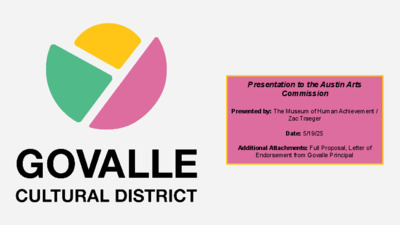Item 04 - Arts Commission Presentation.pdf — original pdf
Backup

Presentation to the Austin Arts Commission Presented by: The Museum of Human Achievement / Zac Traeger Date: 5/19/25 Additional Attachments: Full Proposal, Letter of Endorsement from Govalle Principal Welcome to Govalle East Austin neighborhood with deep creative history Anchored by MoHA, Bike Texas, Canopy, 979 Springdale, Govalle Elementary Major hub for EAST and First Saturdays Vision: A thriving, inclusive district where art, education, green space, and community converge. Five-Year Headline: In 2029, the Govalle Cultural District will continue to be known as a neighborhood where creativity and community thrive—preserving the past, shaping the future, and making space for all to belong. Stakeholder Engagement 3 public meetings, 35 participants 12 in-person interviews, 9 calls Live editing via Google Docs Petition with 87 signatures and volunteer offers SWOT analysis 60 | Individual Artist, Organizer, or Community Member 22 | Small Business 21 | Creative Business 15 | Property Owner 11 | Non-profit Cultural Organization Core Values Grouped into key themes: Youth and intergenerational programming Public art, walkability, and cultural storytelling Affordable space and artist retention Artist economic stability and event activation Community-led planning and green infrastructure Organizational Capacity Fiscal sponsor: The Museum of Human Achievement 13 years of service to East Austin Supports 22 artists + 22 organizations No-fee fiscal sponsorship model via Open Collective $2.2M in grants secured for local creatives (2023–24) Programs, Tools, & Partners City and external support we’re engaging: Identity District Agreement, CAMP updates, planning assistance Creative District Overlay + TCA designation Future advocacy and state/federal grant alignment Collaborations with AISD, private foundations, and local orgs Timeline Overview 2025–26: Pilot youth programs, affordability work, walkability 2027–28: Infrastructure improvements, storytelling, events 2029–30: District legacy, tenure tools, cultural preservation Summary Ready with a plan and community support Aligns with City affordability, and arts goals Unlocks additional public/private funding Builds a replicable model for neighborhood-based district Next Steps Share with City staff and other departments contacts Stay involved as implementation begins Thanks! Questions?